
Cauliflower in the garden
Once you’ve planted and gotten your cauliflower starters established in the garden, you still have work to do, as with any food crop. To start with, you need to keep water and nutrients flowing to your crop.
Watering

Watering mulched cauliflower plants
Because cauliflower needs a steady supply of moisture to avoid stress, it’s a good idea to apply a 3-inch layer of organic mulch around your plants. Then give plants 2 inches of water per week if rainfall isn’t adequate.
Water with a gentle spray nozzle aimed at the soil over the roots. You should water when temperatures are at their coolest, in the morning or evening. You’re aiming for consistently moist soil, not soaking wet.
Another option for making sure your plants don’t dry out is to create a moat around each one, building up a ridge of soil to create the moat. To increase water retention even more, mix some mulch into the soil ridge. This will also protect delicate roots, keep the ground cool, and inhibit weed growth.
And speaking of weeding, you definitely want to slow down the invaders because weeding can be harmful to shallow cauliflower roots.
Fertilizing

Cauliflower seedlings in freshly fertilized soil
Different gardeners have different ideas about fertilizing. Some say that commercial non-organic fertilizers may burn cauliflower’s tender roots. Others recommend commercial high-nitrogen varieties.
Another suggestion is using a phosphorus-rich 33-0-0 starter fertilizer at transplant time, with an additional side dressing three weeks later. Side dressing is applying fertilizer around the plant, just outside the largest leaves, to avoid burning them.
You can also use a slow-release all-purpose granular type of fertilizer. You only have to apply this once, at transplant time. Whatever type of fertilizer you choose, follow the instructions on the label for season-long application times.
What kind of fertilizer do you use with your cauliflower? Please tell us in the comments below.


 Previous
Previous

